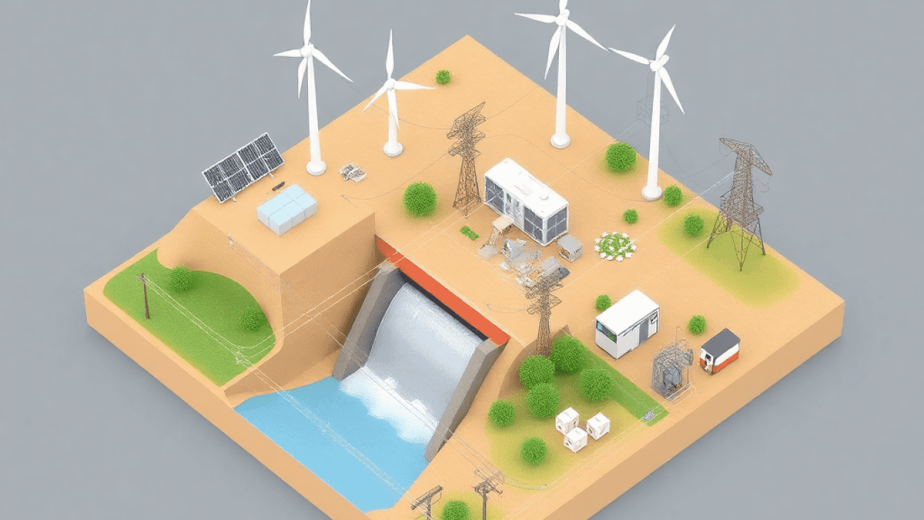Critical infrastructure technology is the backbone of modern society, encompassing systems and services essential for daily operations. Its significance is profound, impacting sectors such as energy, transportation, water supply, and communication.
Key points to consider:
- Predicting future trends is crucial for industry players to maintain competitiveness and adapt to emerging challenges.
- Innovation drives infrastructure management, influencing the design, efficiency, and reliability of these vital systems.
As we look toward 2025 predictions, understanding the evolution of technology within critical infrastructure becomes essential. Embracing cutting-edge advancements can enhance operational capabilities and address potential vulnerabilities. The integration of innovative solutions will shape a resilient future where infrastructure meets the demands of an ever-evolving world.
For those interested in staying updated with the latest trends and news in critical infrastructure technology, resources like Mira Spatial’s news section can provide valuable insights. Additionally, if you have any inquiries or need further information, don’t hesitate to reach out through their contact page.
1. The Role of Advanced Technologies in Critical Infrastructure
The integration of artificial intelligence (AI) into critical infrastructure is transforming operational capabilities across various sectors. By enhancing task-specific functionalities, AI technologies facilitate more efficient processes and decision-making. Examples include:
- Predictive Maintenance: AI algorithms analyze data from sensors to predict equipment failures before they occur, significantly reducing downtime and maintenance costs.
- Smart Grid Management: AI systems optimize energy distribution, balancing supply and demand while improving reliability for electric utilities.
Widespread adoption of AI translates into notable cost savings and efficiency improvements. Organizations leveraging AI can experience:
- Reduced Labor Costs: Automation minimizes the need for manual interventions, allowing human resources to focus on higher-value tasks.
- Increased Productivity: Automated systems operate continuously and accurately, leading to enhanced throughput without compromising quality.
Automation stands as a critical driver for seamless operations within critical infrastructure. Its benefits include:
- Error Reduction: Automated processes lower the risk of human error, which is crucial in sectors where precision is vital, such as healthcare and transportation.
- Scalability: As demand fluctuates, automated systems can adapt quickly without the complexities associated with workforce adjustments.
The combination of AI integration and automation not only enhances operational resilience but also positions organizations to respond proactively to emerging challenges in infrastructure management.
2. Strengthening Cybersecurity Measures for Resilient Infrastructure
The evolving landscape of cyber threats poses significant risks to critical infrastructure. As technology advances, so do the tactics employed by cybercriminals and state-sponsored actors targeting essential systems. Today’s vulnerabilities can be traced to outdated security protocols, insufficient incident response strategies, and the rapid integration of interconnected devices.
1. Understanding Current Risks
Common threats include ransomware attacks, phishing schemes, and data breaches that disrupt operations and compromise sensitive information. The stakes are higher than ever as these incidents can lead to catastrophic consequences in sectors such as energy, transportation, and healthcare.
2. Anticipated Rise in Cyberattacks
Experts predict a surge in sophisticated cyberattacks capable of exploiting even the most secure systems. Consequently, organizations must adopt proactive defense strategies that encompass advanced threat detection mechanisms and comprehensive incident response plans. Continuous monitoring of network vulnerabilities is vital for identifying potential breaches before they escalate.
3. Quantum-Safe Cryptography
As we look toward the future, quantum-safe cryptography emerges as a promising solution to safeguard against evolving security vulnerabilities. Traditional encryption methods may become obsolete with the advent of quantum computing, necessitating the development of new cryptographic techniques designed to withstand quantum attacks. This innovative approach ensures that sensitive data remains protected even in a landscape where quantum capabilities redefine our understanding of cybersecurity.
In addressing these challenges, critical infrastructure stakeholders must prioritize robust cybersecurity measures to fortify their defenses against ever-evolving threats.
3. How Cloud Computing Enables Scalable and Secure Infrastructure Solutions
Cloud computing is changing significantly, mainly because organizations want to cut costs and run their operations more efficiently. Instead of relying on just one cloud service provider, companies are now adopting a multi-cloud approach. This means they can use different providers’ strengths while avoiding the risks of being locked into a single vendor. This flexibility in cloud strategies makes it easier for organizations to scale their operations and bounce back from disruptions, ensuring that critical infrastructure systems can quickly adapt to changing needs.
Sustainability Initiatives
As organizations strive to balance performance with environmental responsibility, sustainability initiatives are becoming increasingly important. Cloud providers are responding by investing in energy-efficient technologies, using renewable energy sources, and implementing sustainable practices throughout their operations. These efforts not only help reduce carbon footprints but also align with the growing demand for corporate social responsibility among consumers and stakeholders.
The Rise of Edge Computing
Another significant trend influencing cloud strategies is the rise of edge computing. By processing data closer to where it is generated, edge computing greatly reduces latency and improves real-time decision-making capabilities. This is particularly beneficial for critical infrastructure sectors like energy and transportation, where faster response times and enhanced operational efficiencies are crucial.
As organizations embrace these advancements in cloud computing, they position themselves to tackle future challenges while ensuring that their critical infrastructure remains strong, scalable, and environmentally friendly.
4. Innovations Driving the Future of Data Centers
The evolution of data centers is being significantly influenced by specialized infrastructure designed to meet the demands of artificial intelligence (AI) applications. As organizations increasingly rely on AI for critical processes, the need for optimized data center environments becomes paramount. Key areas of focus include:
1. Specialized Infrastructure
Data centers are adapting their designs to accommodate AI workloads, which require enhanced computing power and storage capabilities. Tailored solutions such as GPU-optimized servers and high-speed interconnects facilitate seamless processing of vast datasets.
2. Advanced Cooling Systems
As energy demands increase, traditional cooling methods may fall short. Innovative cooling technologies, such as liquid cooling and immersion cooling, provide efficient temperature management while minimizing energy consumption. These systems enhance reliability and performance, crucial for maintaining optimal operation.
The integration of these innovations transforms data centers into more efficient, resilient infrastructures capable of handling the challenges posed by next-generation workloads and environmental responsibility. Such advancements position organizations to harness the full potential of AI while ensuring sustainable practices are upheld within their operations.
5. Workforce Transformation and Skills Development for a Tech-Driven Future
The integration of automation and AI into critical infrastructure is reshaping workforce dynamics, leading to significant transformations within various sectors. As traditional roles evolve, professionals must adapt by embracing new responsibilities that leverage advanced technologies. Companies are increasingly seeking individuals equipped with the skills necessary to navigate an automated landscape.
Key considerations include:
- Emerging Roles: New job positions are arising that focus on managing AI systems, data analytics, and cybersecurity protocols. These roles require a blend of technical knowledge and strategic thinking to enhance operational efficiency.
- Upskilling Necessity: Continuous education in fields such as cybersecurity and quantum computing has become essential. Workers must seek opportunities to gain expertise in these rapidly advancing areas to remain competitive in an evolving job market.
Mira Spatial exemplifies this trend by prioritizing workforce training in cutting-edge technologies. Their commitment to continuous learning ensures that employees are well-equipped to utilize innovative solutions for infrastructure monitoring and analytics.
As automation takes center stage, organizations must create pathways for professional development. This includes:
- Training Programs: Implementing targeted upskilling initiatives focused on AI applications, risk assessment techniques, and data management strategies.
- Collaborative Learning: Fostering a culture of collaboration where team members share knowledge and best practices enhances collective competence in handling technological advancements.
By investing in workforce transformation through effective upskilling strategies, companies can harness the full potential of technology while ensuring their teams are prepared for the challenges ahead.
6. Blockchain’s Emerging Role in Critical Infrastructure Technology
Blockchain technology is increasingly recognized as a game-changer for critical infrastructure systems. Its ability to improve transparency and traceability across complex supply chains is especially important in today’s interconnected world.
1. Supply Chain Transparency
Blockchain enables real-time tracking of assets, providing an unchangeable record of transactions. This transparency helps stakeholders verify the authenticity of products, reducing the risk of counterfeiting or fraud.
2. Mitigating Risks
By using decentralized ledgers, organizations can create more resilient supply chains. Each transaction recorded on the blockchain is secure and easily auditable, ensuring that any discrepancies can be quickly identified and resolved.
3. Case Study Example
Industries such as energy and construction have begun integrating blockchain solutions to streamline operations. For instance, using blockchain for asset tracking can significantly improve accountability in renewable energy projects, ensuring that all components meet regulatory standards.
The integration of blockchain into critical infrastructure not only enhances operational efficiency but also strengthens trust among stakeholders. As we move towards 2025, embracing this technology will be essential for organizations aiming to maintain competitive advantages while addressing the complexities of modern supply chains.
7. Geopolitical Implications for Critical Infrastructure Technology Evolution
The landscape of critical infrastructure technology is increasingly shaped by geopolitical dynamics. Key trends include:
-
U.S. Focus on Domestic Manufacturing: Emphasizing self-sufficiency in critical technologies has become paramount. This shift aims to reduce dependency on foreign supply chains, particularly in sectors that are vulnerable to international tensions. Investments in domestic manufacturing not only bolster national security but also promote economic resilience and job creation within the U.S.
-
Formation of Global Cybersecurity Alliances: As cyber threats evolve, the need for international collaboration becomes crucial. Countries are establishing alliances to share intelligence and resources, enhancing their collective cybersecurity posture. These partnerships aim to combat sophisticated cyberattacks targeting essential services, ensuring a robust defense against emerging threats.
The interplay between domestic initiatives and global cooperation will dictate how nations navigate the challenges posed by technological evolution. As infrastructure systems grow more interconnected, addressing these geopolitical implications will be vital for maintaining security and stability in critical infrastructure management.
8. Evolving Threat Landscape: Preparing for Cyber and Physical Attacks on Critical Infrastructure Systems
The threat landscape facing critical infrastructure is increasingly complex, with state actors such as China and Russia posing significant risks to essential services. These nations have shown they can take advantage of weaknesses in infrastructure systems, potentially causing disruptions that affect everyday life.
Key threats include:
- Cyberattacks: Targeting operational technology (OT) environments, these attacks can lead to system failures, data breaches, and even physical damage.
- Physical assaults: Coordinated actions against facilities or personnel can disrupt services and compromise security.
- Hybrid threats: The combination of cyber and physical strategies increases the need for comprehensive defense mechanisms.
To fight against these evolving threats, organizations must implement strong security measures that include:
- Cyber resilience: Implementing advanced cybersecurity protocols, including intrusion detection systems and regular vulnerability assessments.
- Physical protection: Enhancing site security through surveillance technologies and controlled access measures.
Investing in both cybersecurity and physical security frameworks is crucial. By combining these approaches, we can strengthen our defenses and ensure that critical infrastructure remains resilient against various types of attacks.
9. Public Safety Initiatives and Collaborations Towards a Secure Future
The world of public safety is changing as threats become more complicated and diverse. Working together with different groups is essential to improve security measures against targeted violence or terrorism. The main participants in this effort include:
- Government Agencies: Local, state, and federal entities must work together to create strong systems that address new threats.
- Private Sector Entities: Companies specializing in technology solutions can provide vital resources and expertise for infrastructure protection initiatives.
- Law Enforcement Organizations: Involving law enforcement ensures that security protocols are put into action and monitored effectively.
A strategy that involves multiple aspects brings about a combined strength that improves public safety. New technologies are crucial in this teamwork. For example, using data analysis from platforms like Mira Monitoring enables stakeholders to find weaknesses instantly, allowing them to take preventive actions.
Partnerships between the public and private sectors create collaborations that strengthen defenses against both physical and online dangers. As we approach 2025, the combination of advanced technologies will empower these partnerships, making sure important facilities stay safe despite changing threats. The emphasis on all-encompassing safety plans will be vital in creating a more secure future for every community.
Conclusion: Embracing Innovation for a Resilient Tomorrow
Technological advancements are critical as we navigate a complex landscape where critical infrastructure plays an essential role in daily life. The evolution of these technologies impacts sectors from energy to construction, enhancing efficiency and security.
Key considerations include:
- Staying informed about future predictions that shape industries.
- Recognizing the importance of balancing rapid innovation with potential risks.
As we approach 2025, organizations must embrace change and foster collaboration across sectors. Awareness and adaptability will be vital in leveraging emerging trends while ensuring resilience against challenges. Continuous learning and proactive measures will define success in this ever-evolving environment.



